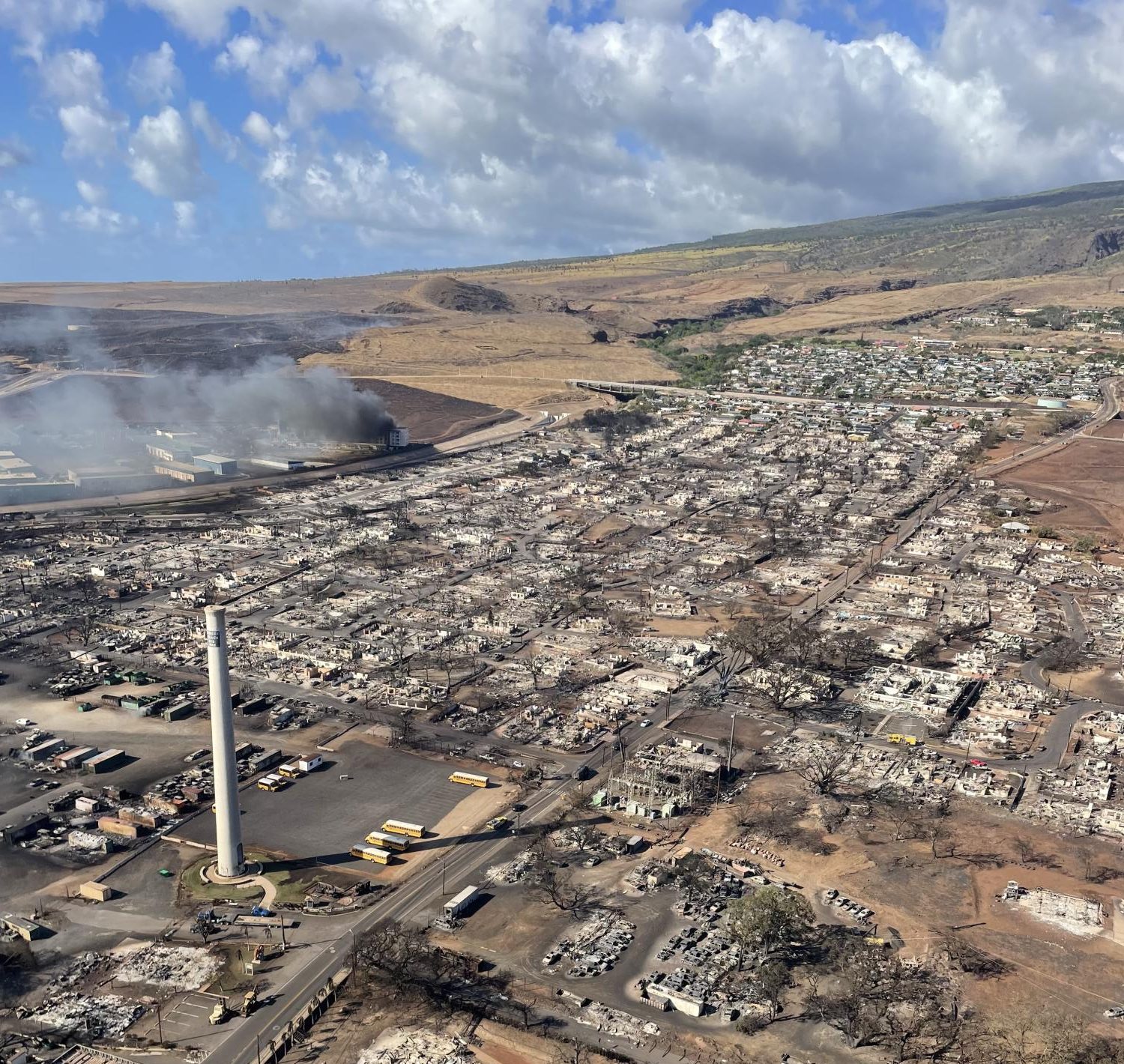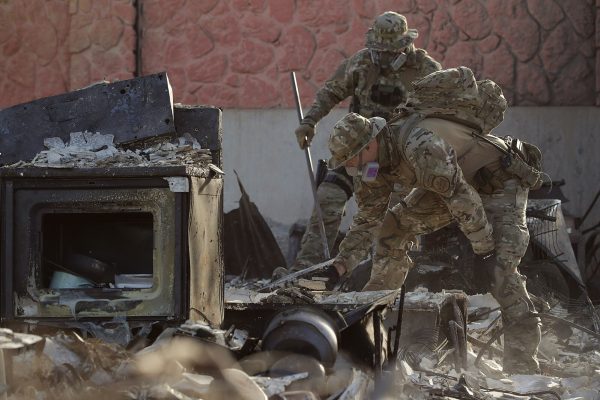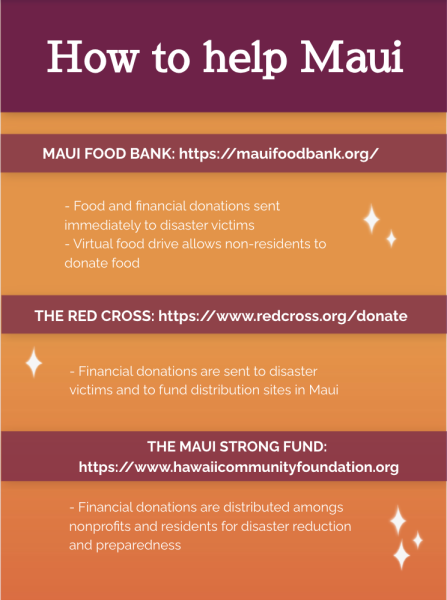
In a press release on Aug. 31, Maui Mayor Richard Bissen addressed the state of the island and the actions he and his team are taking to provide resources, clear the burn zones, and let residents return to their homes in Lahaina.
Despite the quick press release, external assistance to Lahaina came several days after the fires due to the air toxicity and hazardous conditions in West Maui. Almost entirely cut off from the rest of the island and on their own, Lahaina residents immediately collaborated to open community centers and distribute food, clothing, toiletries, and necessities to anyone who needed them.
“Maui is unique in that sense that in the first couple of weeks, everybody I knew was volunteering and donating,” said Maui resident Marina Sternthall. “Donating their time, sending boats out full of supplies, and anything they could do. People pretty much stopped working and just volunteered.”
As someone dependent on assistance from unaffected people, it was heartwarming for Lisa Agdeppa, a fifth-generation Maui native who lost almost everything in the Lahaina fire, to see everyone come together and help the disaster victims.
“It was just amazing to hear how many sites were up and how our community was pulling together to help other community members,” Agdeppa said. “Even the ones that still had their homes, but they were still without power, food, and gas. We were trying to take care of each other.”
Federal aid arrived about three days after the fires started. The Environmental Protection Agency (EPA) began removing hazardous materials and toxins from the disaster areas. Federal Emergency Management Agency (FEMA) began search and rescue operations and opened organized distribution centers across West Maui. In addition, they are providing $700 to each household who applies for financial aid.
The charity organization People’s Fund of Maui has provided assistance to over 8,000 Maui residents since the initial fires.

Despite the offered aid, Agdeppa has found everyone is racing to collect money from wherever is offering it, causing significant delays. This is seen in the government unemployment checks, which commonly take around three weeks to process.
“It’s been over four weeks, and I haven’t seen anything yet, and it keeps saying it’s pending,” Agdeppa said. “But Red Cross, they’re not government affiliated, so they’ve been very, very helpful in providing shelter, food, and necessities.”
National nonprofits like the Red Cross and Salvation Army took over some community-run distribution areas and have since provided over 875,000 meals for Maui residents. Red Cross also helped over 7,600 disaster victims find hotels and condos.
“We go to the distribution centers for food, canned goods, paper towels, bread, and perishables. At this other site, which is more community-based, local farmers provide fresh fruit and produce,” Agdeppa said. “Out of the goodness of everyone’s hearts and generosity, our needs are being taken care of.”
The distribution sites are run solely by volunteers who had flown into Maui nationwide to help disaster victims. Agdeppa believes they are truly going above and beyond; volunteers have listened to her story, given her condolences, and insisted on giving money to help her family. A retired Californian firefighter who was distributing resources stopped her and told her about the beautiful community Maui has.
“He goes, ‘If we were in California right now, and a town experienced the same thing you experienced, there’d people just grabbing everything they can and not leaving anything for anyone. What I see from the people I’ve met who suffered from the fires and lost everything is that you care about each other. And you leave things to ensure that your other friends or family have stuff too,’” Agdeppa said.
In addition, she has had other residents entrust her with dozens of gift cards and clothing items to distribute to other victims, despite being total strangers.
“I met a pastor, and he said, ‘Can you please take these gift cards and give them to whoever needs help with their children?’ Their mission was to help provide children with food, clothing, and school supplies,” Agdeppa said. “People are just giving me gift cards like, ‘If you’re from Lahaina here. Please take this and give it to whoever that needs them.’ That’s a whole bunch of trust.”

However, regardless of the resounding community support from most Maui residents, there are still instances of exploitation regarding free resources and rising prices of commodities.
According to Agdeppa, the Red Cross offered housing aid to displaced disaster victims in nearby hotels and condos. Yet, people not in disaster areas applied and took advantage of the room and resources provided.
Due to this misuse of gratitude, the Red Cross has had to funnel efforts into data cleanups and ID checks to verify residents they are housing have lived in the impact zone, and are the ones that need help.
Agdeppa and Jesse Imbach, the founder and owner of Café Café, a quaint coffee shop and lunch spot that had resided in downtown Lahaina, noted increasing rent prices on some condos and homes. While the rising market prices may be from losing two months of income, Agdeppa believes some are deliberately gouging prices to exploit desperate residents.
“Homeowners and landlords are just taking advantage,” Agdeppa said. “For example, my girlfriend said they found a five-bedroom place, and the landlord offered them a certain amount. And then, the landlord discovered that the Red Cross was giving them an amount of money. And after promising my girlfriend an amount, he goes, ‘Well, no, if you’re gonna get money, I’m gonna raise it.’”
Agdeppa worked at the Honua Kai Condominium Association and has extensive experience with the housing market. She has noted that some residencies not only are too costly for displaced residents to afford and utilize, but they are also far more expensive than similar properties were a few months ago.
Homes aren’t the only commodities with rising prices. Imbach observed inflated costs of food at his local Safeway.
“We went and got a cauliflower. It was $9 — a single cauliflower. A single tomato was over $3,” Imbach said. “Now, I don’t know if that is the price because they aren’t selling that many things, so each is much more expensive. I don’t know why that is. But $9 for a cauliflower seems like good money. And that $3 tomato definitely feels like an expensive tomato.”
The future of Lahaina is up in the air as federal corporations work to salvage the burnt land and non-profits work to keep residents on the island fed, housed, and protected. Agdeppa believes the prosperity and stability of Lahaina in the coming months or years will be partly determined by how resilient the community is, and the priority for a while will simply be ensuring everyone is safe and supported.
Bissen announced a three-phase plan on Sept. 27 to reopen Maui to visitors starting Oct. 8, two months after Lahaina burnt. The greater Lahaina area, excluding the central city, will begin reopening at phase two, despite residents’ requests to keep visitors away from the disaster areas at Kaanapali and the outskirts of Lahaina.
According to Imbach, many residents are irritated with this quick return and believe it highlights the need to step away from tourism as their leading economic sector.
“There’s a lot of frustration; this is the time for us to rethink how dependent we want to be on tourist dollars,” Imbach said. “We probably do need tourist money for a while, but we need to be a lot more thoughtful in the future about becoming dependent on one source of income.”
To add insult to injury, Agdeppa noted many hotels and condos housing displaced disaster victims will eventually force them out so they can be open for tourists.
Most residents who lost their homes depend entirely on the Red Cross or FEMA for housing aid because they don’t have the money to rent a place. Additionally, there are not enough houses, apartments, and condos to house every displaced resident, so once tourism opens again, and visitors flood the hotels, many people do not have the security of knowing where they will go next.
“For now, our need is finding at least a semi-permanent home,” Agdeppa said. “We don’t know how long we can stay and, at least in our condo, they’re privately owned, and they’re going to kick us out when the tourists come. We just want peace of mind right now, and it’s just having shelter.”
Imbach feels this extreme dependency on tourism has degraded Hawaii as a whole and disregards its emotionally complex history. The state isn’t simply for vacationers to kick back and watch the ocean; people live there, have been living there for generations, and turning immediately back to how everything was neglects residents’ history and experiences.
“Folks who have been here for generations have gone through a tremendous amount of emotional turmoil. They are struggling with the idea that our government is trying to push it right back to where it was,” Imbach said. “Lahaina’s future should include many of the wonderful elements that are part of the Hawaiian story, as opposed to reducing them to some plastic pineapple cups at the supermarket.”
Rebuilding Lahaina requires a few key components: laborers, materials, and money. West Maui has none of the above.
“You have to bring people here to do that work, but where will you put them? You need to have materials here before the people are here, but you need the people here to unload the materials, and then what will you feed them? There are no restaurants open, so you need people to open restaurants to feed the people building the houses. But the restaurants can’t be open because they’ll make no money with no tourists here,” Imbach said.
Maui also has had a housing shortage for years. Compounded by the destruction of hundreds of buildings, there isn’t enough even for residents, much less for tourists and workers. According to Agdeppa, there is currently no feasible way to ship in a thousand laborers to begin reconstructing the city; quite simply, there is no space.
Part of the plan to restore Maui’s economy was reopening the West side in three phases; however, this doesn’t address the underlying issue. Until there is a tourist hub there again, the draw to Maui is the East side, where visitors can walk to some 20 different restaurants and shops within a mile of each other, not the desolate wastes of Lahaina and its surrounding cities.
“We have a starting-off problem, and it’s not gonna be resolved by tourists coming here with nothing to do,” Imbach said. “They can golf and go to the ocean on this side of the island. Those are about the only two things left because the stores are closed. Well, if you’re a tourist, are you going to choose to do that or are you going to go to the other side of the island where you can do those two things, and you can go to 40 restaurants and do some shopping?”
With tourism primarily centered around the West side for years, East Maui cannot support the whole island. To jumpstart rebuilding, Imbach believes the government needs to step up and provide financial aid to the island to begin establishing a city and to business owners who will draw tourists to West Maui.
In a press release, Bissen announced that it would take at least 18 to 24 months to clear the burn sites enough for mass construction. With this far-out timeline, the local Maui economy will be unstable for several years while the island will use state-wide funds to support recovery.
The hope for many natives is over the next several years of rebuilding Lahaina, there will be more discussions on an independent economy that won’t leave the island stuck in a tourist-driven cycle.
“It’s not ideal for Maui to be entirely dependent on tourism,” Imbach said. “I’m hopeful that the rebuilding process includes a lot of those voices of people who didn’t get their voice heard in the past and that we do a better job and maybe capture a little bit of the original magic of the Hawaiian Islands.”
The Maui wildfires caused insurmountable damage and emotional distress to residents. Yet, rather than viewing this as an opportunity to improve, the state and national governments are falling back into perpetual cycles of economic dependency and reducing the Hawaiian story to plastic souvenirs at the grocery store.
Protests against reopening to tourism organized by natives highlight how reversion to the old system suppresses island prospects.

“I just see no vision for where we need to go in the future, and it’s exhausting. I don’t think they understand how incredibly eerie, desolate, lonely, and tragic it is just surveying incredible destruction,” Imbach said.
Lahaina will rebuild. The community that rushed together to help each other escape the fires and find shelter will recover together.
“We’re all hit with this onslaught of deep emotions, and everyone grieves differently, but I have waves of grief that overcome and overwhelm me,” Agdeppa said. “We get through it day by day. That’s just how we live now – day by day. We don’t know what will happen tomorrow or 30 days later.”
The future of Maui will not be built on top of the past systems, covering it up and hiding it from the world. It will be built next to it as Lahaina serves as a warning and promise to the world of what is to come.
“The things that have made up the past will not necessarily make up the future,” Imbach said. “It’s imperative for us to make better choices looking forward, as opposed to trying to rebuild what was yesterday, because this is not the last time this will happen in Hawaii. This is not the last time we’ll lose a city. We need to do an even better job of responding to these disasters and making a more resilient culture. And right now, I see no evidence of that vision anywhere.”
“Disaster in paradise: the Maui wildfires” is the first part of this two-part feature article. To read the first part of this feature, click here.


